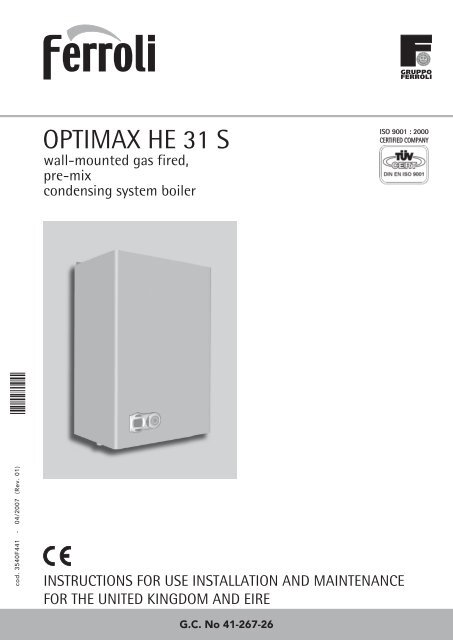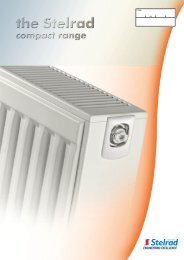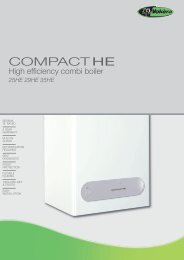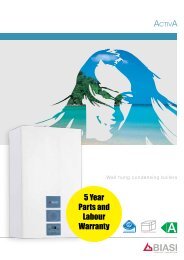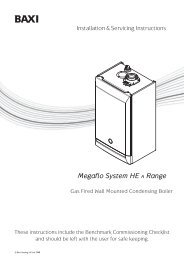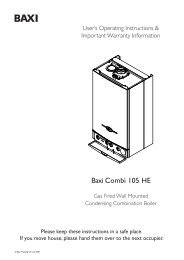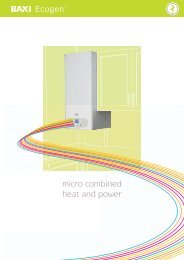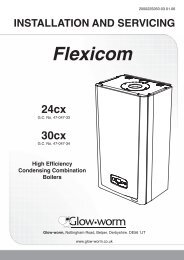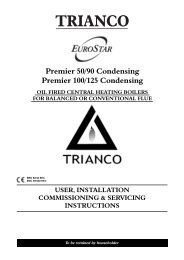OPTIMAX HE 31 S - Heatingspares247.com
OPTIMAX HE 31 S - Heatingspares247.com
OPTIMAX HE 31 S - Heatingspares247.com
Create successful ePaper yourself
Turn your PDF publications into a flip-book with our unique Google optimized e-Paper software.
<strong>OPTIMAX</strong> <strong>HE</strong> <strong>31</strong> S1.2 Control panel8 12 5 1571112ecocomfortreset143 4 136fig. 11 = Domestic Hot Water temperature setpoint decreasing push button (not used)2 = Domestic Hot Water temperature setpoint increasing push button (not used)3 = Central Heating water temperature setpoint decreasing push button4 = Central Heating water temperature setpoint increasing push button5 = Display LCD6 = Reset7 = On-Off push button8 = Domestic Hot Water symbol11 = Multi-function indication12 = Degrees indication13 = Central Heating mode operation14 = Central Heating symbol15 = Burner on and actual load indicationIndication during boiler operationDemand modeThe Boiler heat demand (generated by the Programmer, room thermostat and cylinder thermostat) isindicated by the flashing of the Hot Air symbol over the radiator (part. 13 and 14 – fig. 1). The displayindicates the actual System water temperature (part. 11 – fig. 1).ecocomfortresetfig. 2Cod. 3540F441 - 03/2007 (Rev. 01)5
<strong>OPTIMAX</strong> <strong>HE</strong> <strong>31</strong> S1.3 Turning ON and OFFWithout main power supplyecocomfortresetfig. 3 - Boiler without main power supplyTo avoid damage caused by freezing during long shutdowns in winter, it is advisable to drain allwater from the system.IgnitionEnsure the power is on to the appliance.ecocomfortresetecocomfortreset••••For the first 120 seconds, the display shows FH that identifies the Air purge function.During the first 5 seconds, the display shows the software version of the pcb.Open the gas cock on the boiler and purge the air from the pipework upstream of the gas valve.When the FH disappears, the boiler is ready to function automatically whenever the external controlsare calling for heat.Turning offPress thefig. 4 - Ignition(part. 7 - fig. 1) for 5 seconds.fig. 5 - Air purgeecocomfortresetfig. 6 - Turning off6 Cod. 3540F441 - 03/2007 (Rev. 01)
<strong>OPTIMAX</strong> <strong>HE</strong> <strong>31</strong> SWhen the boiler is turned off with this key, the p.c.b is still powered, heating operation is disabled andthe display is off however the frost protection will still be active.To totally isolate close the gas cock ahead of the boiler and disconnect electrical power.To avoid damage caused by freezing during long shutdowns in winter, it is advisable to drain allwater from the system.To turn the boiler on again, press(part.7 - fig.1) for 5 seconds.ecocomfortresetIf there is no heat demand, the display shows the actual water pressure (bar/10).The boiler is ready to function automatically whenever the external controls are calling for heat.fig. 71.4 AdjustmentsHeating temperature settingTo set the system flow temperature, use the CH push buttonsvaried from a minimum of 20°C to a maximum of 90°C.(Part. 3 and 4 – fig. 1). It can beecocomfortresetfig. 8Room temperature adjustment (using a room thermostat )Using the room thermostat, set the temperature desired in the rooms. Controlled by the room thermostat,the boiler lights and heats the system water to the system delivery setpoint temperature. Theburner shuts down when the desired temperature in the room is reached.A room thermostat and programmer are a mandatory requirement (Building regulations Doc ‘L’2002).Cod. 3540F441 - 03/2007 (Rev. 01)7
<strong>OPTIMAX</strong> <strong>HE</strong> <strong>31</strong> S1.5 MaintenanceIt is strongly recommended to carry out annual maintenance of the boiler and heating system. Pleaserefer to the “maintenance” section in this manual.The casing, the control panel and the aesthetic parts of the boiler can be cleaned using a soft and dampcloth, do not use abrasives or solvents.1.6 FaultsIn the unlikely event of an operating problem, or component failure, the display flashes and a faultidentification code appears.The boiler is equipped with an advanced self-diagnosis system that signals any faults on the display.Some faults (“A“ indication) cause a boiler shutdown. In this case, operation must be reset manually byresetpressing the (Part. 6 – fig. 1) for 1 second.Other faults (“F“ indication) cause temporary shutdowns that are automatically reset as soon as thevalue causing the fault comes back within the boiler’s normal working range.Listed below are some anomalies that can be caused by simple, user-solvable problems.If the problem remains after two attempts at resetting, contact the Ferroli Service Centre.For other faults, refer to section 3.4 “Troubleshooting”.FaultCureNo burner ignitionMake sure that the gas cocks ahead of the boilerand on the meter are open.Press the RESET button (for 1 second).In case of repeated shutdowns, contact the FerroliService Department.Low system pressureFill the ‘system to 1-1.5 bar.Before calling a Ferroli service engineer, check that the problem is not due to there being nogas or electricity, or low system pressure.8 Cod. 3540F441 - 03/2007 (Rev. 01)
<strong>OPTIMAX</strong> <strong>HE</strong> <strong>31</strong> S2. INSTALLATION2.1 General InstructionsThis device must only be used for the purpose for which it is specially designed. This unit isdesigned to heat water to a temperature below boiling point and must be connected to a heatingsystem and/or a water supply system for domestic use, compatible with its performance,characteristics and its heating capacity. Any other use is considered improper.BOILER INSTALLATION MUST ONLY BE PERFORMED BY QUALIFIED PERSONNEL, IN ACCORDANCEWITH ALL T<strong>HE</strong> INSTRUCTIONS GIVEN IN THIS TECHNICAL MANUAL, T<strong>HE</strong> PROVISIONS OF CURRENTLAW, T<strong>HE</strong> RECOMENDATION OF BS STANDARDS, ANY LOCAL REGULATIONS AND T<strong>HE</strong> RULES OFCOMPETENT WORKMANSHIP.IN IE, T<strong>HE</strong> INSTALLATION MUST BE CARRIED OUT BY A COMPETENT PERSON IN ACCORDANCEWITH T<strong>HE</strong> CURRENT EDITION OF I.S. 813 “DOMESTIC GAS INSTALLATIONS”, T<strong>HE</strong> CURRENT BUILD-ING REGULATIONS AND REFERENCE SHOULD BE MADE TO T<strong>HE</strong> CURRENT ETCI RULES FOR ELEC-TRICAL INSTALLATIONS.Incorrect installation can cause damage or physical injury for which the manufacturer declines any responsibility.This appliance must be installed strictly in accordance with these instructions andregulations:The Gas Safety Regulations (Installations & Use).The Local Building Regulations.The Building Regulations (Part L).The Buildings Standards (Scotland - Consolidated) Regulations.British Standards Codes of Practice:B.S. 5440 Part 1 FluesB.S. 5440 Part 2 Air supplyB.S. 5449 FORCED CIRCULATION HOT WATER SYSTEMSB.S. 6798 INSTALLATION OF GAS FIRED HOT WATER BOILERSB.S. 6891 GAS INSTALLATIONSB.S. 7671 IEE WIRING REGULATIONSB.S. 4814 SPECIFICATION FOR EXPANSION VESSELSB.S. 5482 INSTALLATION OF LPGB.S. 7593 TREATMENT OF WATER IN DOMESTIC HOT WATER CENTRAL <strong>HE</strong>ATING SYSTEMSB.S. 5546 INSTALLATION OF HOT WATER SUPPLIES FOR DOMESTIC PURPOSESI.S. 813 DOMESTIC GAS INSTALLATIONS (EIRE ONLY)Model Water Bye LawsB.S. 5955-8 PLASTIC PIPEWORK INSTALLATIONFor Northern Ireland the rules in force applyCod. 3540F441 - 03/2007 (Rev. 01)9
<strong>OPTIMAX</strong> <strong>HE</strong> <strong>31</strong> S2.2 Boiler locationThe unit’s combustion chamber is sealed offfrom the installation room and therefore requiresno compartment ventilation.The installation room must be sufficiently wellventilated to prevent any dangerous conditionsfrom forming in the event of even slightgas leakage. This safety standard is requiredby the EEC Directive no. 90/396 for all gasunits, including those with a so-called sealedchamber.Therefore the place of installation must befree of dust, flammable materials or objectsor corrosive gases. The room must be dry andnot subject to freezing.The boiler is designed to be installed on a solidwall. The wall fixing must ensure a stable andeffective support for the appliance, using thebracket and fixings supplied.If the unit is enclosed in a cupboard or mountedalongside, there must be space for normalmaintenance work. Fig. 9 and tab. 1 give theminimum clearances to leave around the unit.ACADBfig. 9Table 1MinimumABCD2,5 cm20 cm30 cm60 cm(via an openable panel)Safe Handling of SubstancesCare should be taken when handling the boilerinsulation panels, which can cause irritation to the skin. No asbestos, mercury or CFCs are included inany part of the boiler.Product Handling AdviceWhen handling or lifting always use safe techniques - keep your back straight, bend your knees, don’ttwist - move your feet, avoid bending forwards and sideways and keep the load as close to your bodyas possible.Where possible transport the boiler using a sack truck or other suitable trolley.Always grip the boiler firmly, and before lifting feel where the weight is concentrated to establish thecentre of gravity, repositioning yourself as necessary.10 Cod. 3540F441 - 03/2007 (Rev. 01)
<strong>OPTIMAX</strong> <strong>HE</strong> <strong>31</strong> SThe isolation valve kit shown in Fig. 11 is supplied as standard.KeyA = NutB = Compression oliveD = 3/4” seal (green)F = 1/2” gas seal (blue)G = FilterH = CapDAB22Flow isolation valveREDFAB22Gas isolation valveYELLOWDfig. 1122ABGHReturn isolation valveBLUEMake Up WaterProvision must be made for replacing water lost from the sealed system. Reference should be madeto BS6798, for methods of filling and making up sealed systems. There must be no direct connectionbetween the boiler's central heating system and the mains water supply. The use of mains water tocharge and pressurise the system directly, is conditional upon the Local Water Byelaws. Again any suchconnection must be disconnected after use. Ensure the filling point is on the return pipe to the boiler.Attention - is drawn to the Model Water Byelaws.Key1. C.H. filling valve.2. Temporary connection.3. Cold water supply valve.4. Double check valve.342Fig. 12112 Cod. 3540F441 - 03/2007 (Rev. 01)
<strong>OPTIMAX</strong> <strong>HE</strong> <strong>31</strong> SThe user must never change the unit’s power cable. If the cable gets damaged, switch off the unitand have it changed only by professionally qualified personnel. If changing the electric power cable,use only “HAR H05 VV-F” 3x0.75 mm 2 cable with a maximum outside diameter of 8 mm.Access to the electrical terminal blockFollow the instructions given in fig. 13 to access the electrical connection terminal block. The layout ofthe terminals for the various connections is given in the wiring diagram in the Technical Data chapter.fig. 13Key62 Time Clock (optional)Warning: theroom thermostatworks at230VRoom thermostatfig. 14Remove connections 5 - 6 if external control fitted.If using external controls the switched line can be connected into terminal 5 of the electricalblock ( see fig 15 and 16 ).14 Cod. 3540F441 - 03/2007 (Rev. 01)
<strong>OPTIMAX</strong> <strong>HE</strong> <strong>31</strong> SCentral heating DemandThe heat demand can be controlled by the room thermostat (terminal 5-6) or by a switch line 230 V(terminal 5).Standard SystemsFor a general pipe layout and wiring diagram on the “S” and “Y” plan systems please see fig.15a, 15b, and 16a, 16b.<strong>OPTIMAX</strong> “S” PlanPipe layoutAuto air vent<strong>OPTIMAX</strong>FERROLIBOILERD.H.W.Zone ValveC.H.Zone ValveFig. 15aWiring diagramJunction Box6 54 3 2 1LN E LNELRemoveLinkbetweenterminals 5-6Terminal 5 - SWITCH LINE1 2 3 4 5 6 7 8 9 10230 Vacfused at3 ampsPROGRAMMERDHW ONCH ONNEUTRALLIVERoom ThermostatBROWNBLUECHzonevalveDHWzonevalveCylinder ThermostatGREYORANGEFig. 15bCod. 3540F441 - 03/2007 (Rev. 01)15
<strong>OPTIMAX</strong> <strong>HE</strong> <strong>31</strong> S<strong>OPTIMAX</strong> “Y” PlanPipe layoutAuto air vent<strong>OPTIMAX</strong>FERROLIBOILERfig. 16aWiring diagramJunction BoxHoneywell V4073H mid position6 54 3 2 1Remove Terminal 5 - SWITCH LINELinkbetweenterminals 5-6LNL1 2 3 4 5 6 7 8 9 10NEL240 Vacfused at 3 ampsPROGRAMMERNEUTRALLIVECH ONDHW ONDHW OFF3 WAY ZONE VALVEBLUEWHITEGREYORANGERoom Thermostat21C2.6 Flue systemCylinder Thermostatfig. 16bThe unit is “type C” with a sealed chamber and forced draught, the air inlet and flue outlet must beconnected to one of the following flue systems. With the aid of the tables and methods of calculation indicated,before commencing installation, it is first necessary to check that the flue system does not exceedthe maximum permissible length. The current standards and local regulations must be observed.It should be noted that only Ferroli flue system and accessories should be used on this appliance,as per BS 5440 2000 and C.E. test certification.16 Cod. 3540F441 - 03/2007 (Rev. 01)
ecocomfortreset21 30 BAR4<strong>OPTIMAX</strong> <strong>HE</strong> <strong>31</strong> SConnection with concentric flue systemThe unit can be connected to a concentric air/flue duct with a Horizontal or Vertical outlet as shown onthe following drawings. Numerous accessories are available on request to meet the various installationrequirements. Please refer to our “flue manual” or the price list.Standard concentric flue installationStandard 1KWMA53AFlue kitRear OutletSide viewPSide OutletFront view95S50*125L9530* = between10 e 60 mm95 30 50** = between10 e 60 mm8080Install level232 218Install levelDSView from aboveView from above156Drill the wall 10÷20 mmmore than the pipe diameterDrill the wall 10÷20 mmmore than thepipe diameter232156218Install level3095Install level232 218D S 50*L95S 50*fig. 17aPP = S + 145 mmfig. 17bL = S + D + 203 mmHorizontal flue installation1. Define the position for installing the unit.2. If using standard flue (1KWMA53A) this must be installed level, for non-standard flue lengths over1mtr a fall of 3 mm per metre should be incorporated back to the boiler.3. Make a hole of diameter 10 - 20 mm greater than the nominal diameter of the concentric pipe used.4. If necessary, cut the terminal length to size, ensuring that the external pipe protrudes from the wallby between 10 and 60 mm (fig. 17a and 17b). Remove the cutting burrs.5. Connect the flue to the boiler, positioning the seals correctly. Seal the flue into the wall with siliconeor sand + cement and cover with wall seals provided.Flue seals should be lubricated with a silicone type grease to prevent damage (grease not supplied)Cod. 3540F441 - 03/2007 (Rev. 01)17
ecocomfortreset21 30 BAR4<strong>OPTIMAX</strong> <strong>HE</strong> <strong>31</strong> SVertical OutletThe total length in equivalent metres of the concentric flue must not exceed the maximum lengths statedin the following table, note that each bend gives rise to the stated reduction. For example, a duct = 60/100composed of 1 bend of 90° +1 horizontal metre + 2 bends of 45° + 1 horizontal metre has a total equivalentlength of 4 metres.Vertical flueingThe installation of a concentric vertical flue can be carried out as follows,Install the appliance as previously mentioned in this manual.1. Connect onto the flue assembly at the top of the appliance a concentric vertical adaptor part number1KWMA71W,2. Use the required amount of 1mtr flue extensions (part number 1KWMA56U) inserting them spigotdown ensuring the seals are well lubricated with silicone grease (not supplied) and correctly locatedinto the sockets.3. If required 45° bends (Part number1KWMA64A)may be used with a resistance value of 0.5mtrseach, the flue should be routed in such awayto avoid any unnecessary deviation and thusminimise the amount of bends required.4. The termination should be made through ourconcentric flue outlet (part number 1KWMA83U)in conjunction with a roof slate pitched (partnumber 1KWMA82U) or flat roof (part number1KWMA81U) The storm collar must be fixed onusing the three screws provided and sealed withan external grade silicone (not supplied).5. For longer flue lengths a 125mm concentric fluesystem is available.6. All flue installations must comply with BS5440part 1 and must only be of Fèrroli manufacture.The vertical flue must continually rise and besupported throughout its length. The flue mustbe inspected whilst commissioning the applianceto ensure it is sound throughout its length.Vertical Terminal1KWMA83UPitch roof slate1KWMA82U1KWMA56U950501000 1251050max. 6 mt 60/100max. 16 mt 80/125This information is for guidance purposes and Fèrroliwill in no way be held responsible for incorrectinstallation following this guide.50 9501KWMA71W950Table 2aØ mm60/100Ø mm80/1255068Maximum permissibleduct length (Horizontal)5 m 15 mMaximum permissibleduct length (Vertical)6 m 16 mTable 2bReduction factors for bends1 m0,5 m0,5 mfig. 17c0,25 m18 Cod. 3540F441 - 03/2007 (Rev. 01)
ecocomfortreset21 30 BAR4<strong>OPTIMAX</strong> <strong>HE</strong> <strong>31</strong> SConnection with 80 mm pipe systemThe unit can be connected to a system of separate air/fluepipes for a Horizontal or Vertical outlet as shown fig 18 - 19. Numerous accessories are available on request to meetthe various installation requirements. The componentsused most frequently are stated in tables 4 - 5. Pleaserefer to the flue manual or the price list for additionalcomponents.To check you do not exceed the maximum permissibleflue length, it is necessary to make a simple calculationbefore installation:KWMR54A112Ø80FLUEØ80AIR120 120 98Removethe closingcap1561. For each component, tables 4 - 5 provide an “equivalentloss in linear metres”, depending on the positionof installation of the component (with air intake or flueextraction, vertical or horizontal).The loss is called “equivalent length” since it is comparedto the loss of one metre of flue (defined as equal to 1).For example, a bend at 90° of Ø80 in flue extraction hasan equivalent loss of 2 linear metres, i.e. it has a lossequal to that of 2 linear metres of flue length.1KWMA84U5330fig. 182. After completely defining the layout of the system of splitflues, add up the losses in equivalent metres, dependingon the installation position, of all the components andaccessories in the system.1KWMA82U3. Check that the total calculated loss is less than or equalto 55 equivalent metres, i.e. the maximum permissiblefor this model of boiler.For complete flue options please contact ferroli orcheck our comprehensive flue manual.1KWMA83WTable 3Ref.DescriptionEquivalentloss42241815Vertical air pipe Ø80Vertical flue pipe Ø8018 m24 m1KWMR54A5180 Ø vertical flue Kit12 mTotal54 mfig. 19Cod. 3540F441 - 03/2007 (Rev. 01)19
<strong>OPTIMAX</strong> <strong>HE</strong> <strong>31</strong> STable 4 Table 5Equivalent losses inmetres (linear)Accessories Ø 80 Air Flue Accessories Ø 80Equivalent losses inmetres (linear)AirFlueDescriptionVerticalHorizontalVerticalHorizontalDescriptionVerticalHorizontalVerticalHorizontalPipe Ø 80male-femaleHorizontalflue terminal1KWMA86A51KWMA83W • 1,00 m1 1 1.6 2Horizontalair terminal1KWMA85A2Bend 45° Ø 80 mmmale - female1KWMA65W1.2 1.8Vertical flueterminalBend 90° Ø 80 mmmale - female1KWMA84U121KWMA01W1.5 2.0The stated loss values refer to genuine Ferroli flue accessories.Terminal PositionPQQlTable of Ø80 flue and accessoryD, EFQJLGBACMNNH HMKfig. 2020 Cod. 3540F441 - 03/2007 (Rev. 01)
<strong>OPTIMAX</strong> <strong>HE</strong> <strong>31</strong> SMinimum Dimensions of Flue Terminal PositionsABCDEFGHIJKLMNOPQNOTEDirectly below an opening, air brick,opening windows, etc.Above an opening, air brick,opening windows, etc.Horizontally to an opening, air brick,opening windows, etc.Below gutters, soil pipes or drain pipesBelow eavesBelow balconies or car port roofFrom a vertical drain pipe or soil pipeFrom an internal or external cornerAbove ground roof or balcony levelFrom a surface facing the terminalFrom a terminal facing the terminalFrom an opening in the car port (e.g. door,window) into the dwellingVertically from a terminal on the same wallHorizontally from a terminal on the same wallFrom the wall on which the terminal is mountedFrom a vertical structure on the roofAbove intersection with roof300mm300mm300mm75mm200mm200mm150mm100mm300mm600mm1200mm1200mm1500mm300mmN/A150mm300mmN/A = Not applicableIn addition, the terminal should not be nearer than 150mm (fanned draught) to anopening in the building fabric formed for the purposeof accommodating a built-in element such as a window frame.Condensing Terminal Positions: If the flue is to be terminated at low level, then thepotential effect of the plume must be considered.The plume should not be directed:across a frequently used access routetowards a window or dooracross a neighbouring propertyCod. 3540F441 - 03/2007 (Rev. 01)21
<strong>OPTIMAX</strong> <strong>HE</strong> <strong>31</strong> SConnection to collective flues or single flues with natural draughtIf you are then going to connect the <strong>OPTIMAX</strong> <strong>HE</strong> <strong>31</strong> S boiler to a collective flue or a single flue withnatural draught, the flue must be expressly designed by professionally qualified technical personnel inconformity with the standards and rules in force.In particular, flues must have the following characteristics:• Be sized according to the method of calculation stated in the standard• Be airtight to the products of combustion, resistant to the fumes and heat and waterproof for thecondensate• Have a circular or square cross-section (some hydraulically equivalent sections are permissible), witha vertical progression and with no constrictions• Have the flue conveying the hot fumes adequately distanced or isolated from combustible materials• Be connected to just one unit per floor, for at most 6 units in all (8 if there is a compensation duct oropening)• Have no mechanical suction devices in the main ducts• Be at a lower pressure, all along their length, under conditions of stationary operation• Have at their base a collection chamber for solid materials or condensation of at least 0.5 m, equippedwith a metal door with an airtight closure.2.7 Condensate outlet connection0,5 lt.ABfig. 21The boiler is equipped with an internal air-trap to drain off the condensate. Fit the inspection couplingA and the hose B, pushing it on for approximately 3 cm and securing it with a clamp.Fill the air-trap with approximately 0.5 ltrs of water and connect the hose to the waste system, orsoakaway.22 Cod. 3540F441 - 03/2007 (Rev. 01)
<strong>OPTIMAX</strong> <strong>HE</strong> <strong>31</strong> SCondensate dischargeWhere possible the condensate should discharge into an internal soil pipe or waste system. The minimumpipe diameter required is 22 mm, a trap has already been fitted to the appliance with a flexible tail tofacilitate the connection to the condensate discharge pipe.The pipe should be a solvent weld plastic, not copper, as the condensate has a ph value of 4 (slightlyacidic).Where it is not possible to terminate internally, the condensate discharge pipe may be run outside (seebelow drawing).Any external run is subject to freezing, in severe weather conditions. To avoid this the pipework shouldbe installed to dispose of the condensate quickly, with as much as possible run internally, before passingthrough the wall.Pipework external to the building should be increased in diameter to 32 or 40 mm solvent weld. It shouldbe run to a external drain or soakaway, with a maximum length of 3 metres.When a soakaway (condensate absorption point) is used, it should be constructed as shown below, oruse a specifically designed unit, for example Mc Alpine SOAK1GR available from most plumbing andheating stockists.InternalExternal32/40mm Solvent weld pipeworkCement sealGround level (either/Or)25mm100mm Dia tube-300mmLime stone chippingsHole depth 400mmBottom sealed2 Rows of3x12 mm Holesfig. 22Cod. 3540F441 - 03/2007 (Rev. 01)23
<strong>OPTIMAX</strong> <strong>HE</strong> <strong>31</strong> S3. SERVICE AND MAINTENANCE3.1 AdjustmentsAll adjustment and conversion operations must be carried out by Qualified Personnel such as ferroliTechnical Service.FERROLI declines any responsibility for damage or physical injury caused by unqualified and unauthorizedpersons tampering with the device.Gas supply conversionThe unit can function with either Natural Gas or LPG (commercial propane)and is factory-set for use withone of the two gases, as clearly shown on the packing and on the unit’s dataplate. Whenever a differentgas to that for which the unit is preset has to be used, a conversion kit will be required, proceeding asfollows:1 Remove the casing.2 Open the airtight chamber.3 Unscrew the gas coupling A on the air/gas mixer.4 Replace the injector in the mixer with the one contained in the conversion kit.5 Refit the coupling A and check the connection is gastight.6 Apply the sticker, contained in the conversion kit, near the dataplate.7 Fit the airtight chamber and casing back on.8 Adjust the parameter for the specific type of gas to be used:- Turn the boiler onto standby- Press the DHW buttons (part. 1, 2 - fig. 1) for 10 seconds: the display will show “P01”blinking- Press the DHW buttons (part. 1, 2 - fig. 1) to set parameter 00 (for natural gas operation)or 01 (for LPG operation)- Press the DHW buttons (part. 1, 2 - fig. 1) for 10 seconds- The boiler will go back onto standby9 Check working pressure.10 Check CO 2mixture as detailed (page 27 combustion analyser testing).ANatural gasLPGInjector ØSee technical data tablefig. 2324 Cod. 3540F441 - 03/2007 (Rev. 01)
<strong>OPTIMAX</strong> <strong>HE</strong> <strong>31</strong> S3.2 System start-upCommissioning must be performed by Qualified Personnel.Checks to be made at first ignition, and after all maintenance operations that involved disconnectingfrom the systems or an intervention of a safety device.Before lighting the boiler:• Open any isolation valves between the boiler and the system.• Check the tightness of the gas system, proceeding with caution and use gas leak detection fluid todetect any leaks in connections.• Check the pre-filling of the expansion tank (ref. sec.4.4)• Fill the water system and make sure that all air contained in the boiler and the system has been ventedby opening the air vent valve on the boiler and any vent valves on the system.• Make sure there are no water leaks in the system, hot water circuits, connections or boiler.• Make sure the electrical system is properly connected.• Make sure that the unit is connected to a good earthing system.• Make sure there are no flammable liquids or materials in the immediate vicinity of the boiler.• Vent and spin the pump.• Ensure the flue system is correctly fitted, including terminal locations.Ignition• Open the gas valve upstream of the boiler.• Purge the air from the installation pipework to the appliance.• Switch on the boiler electrical supply.• Press the key on the boiler for 5 seconds (part. 7 - fig. 1).• The boiler is now ready to function automatically whenever the external controls call for a demand.In case of an electrical power failure while the boiler is working, the burner will go out. Whenpower returns, the boiler will run the self-test cycle again, after which the burner will automaticallyre-ignite (if there is still demand for heat).Checks during operation• Check the tightness of the gas circuit and water systems.• Check the efficiency of the flue and air-flue ducts while the boiler is working.• Check that the water is circulating properly between the boiler and the system.• Make sure that the gas valve modulates correctly.• Check the proper ignition of the boiler by performing various tests, turning it on and off with theroom thermostat or remote control.• Make sure that the fuel consumption indicated on the meter corresponds to that given in the technicaldata table in section 4.4 page 33Turning offPress the key for 5 seconds (part. 7 - fig. 1).Cod. 3540F441 - 03/2007 (Rev. 01)25
<strong>OPTIMAX</strong> <strong>HE</strong> <strong>31</strong> S3.3 MaintenanceThe following operations are strictly reserved for Qualified Personnel, such as corgi registeredengineers or Ferroli engineers.Seasonal inspection of the boiler and flueIt is advisable to carry out the following checks at least once a year:• The control and safety devices (gas valve, flow meter, thermostats, etc.) must function correctly.• The flue terminal end piece and ducts must be free of obstructions and leaks.• The gas and water systems must be sound.• The burner and exchanger must be clean.• The electrodes must be free of scale and correctly positioned.• The system pressure when cold must be approx 1 bar; otherwise, bring it to that value.• The expansion vessel must be filled to 1 bar cold with zero system pressure.• The gas flow and pressure must correspond to that given in table 10 section 4.4 page 33.• The circulating pump must be vented and free of debris.• The returned filter cleaned.• The condensate trap inspection bowl should be cleaned and free of debris.26 Cod. 3540F441 - 03/2007 (Rev. 01)
ecocomfortreset21 30 4 BARecocomfortreset21 30 4 BAR<strong>OPTIMAX</strong> <strong>HE</strong> <strong>31</strong> SOpening the casingTo open the boiler casing, you need to follow the sequence given belowand the instructions of fig. 24.1 Using a screwdriver, fully unscrew and remove the 2 screws “A ”2 Open by lowering the panel “B ”3 Lift and take off the casing “C ”Cfig. 24AABCleaning the boiler and burnerThe body and burner must not be cleaned with chemical products or wire brushes. Special care mustbe taken over all the sealing systems pertaining to the sealed chamber (gaskets, cable clamps, etc.). Inaddition, it is necessary to pay attention after performing all these operations to check and carry out allthe phases of ignition and thermostat operation, the gas valve and circulation pump.After these checks, make sure there are no gas leaks.Combustion analysisIt is possible to analyse the combustionthrough the air and flue sampling pointsshown in fig. 25.To make the measurement, it is necessaryto:1) Open the flue sampling point2) Insert the probe;3) Press CH button (part. 3, 4 - fig. 1)for 5 seconds to turn on TEST mode;4) Wait 10 minutes for the boiler to stabilize5) Take the measurement.NAT GAS; CO2 reading should be 8.7 to 9.0%L.P.G; CO2 reading should be 9.5 to 10%AirFlue gasfig. 25AirFlue gasReadings taken with an unstabilized boiler will cause measurement errors.Cod. 3540F441 - 03/2007 (Rev. 01)27
<strong>OPTIMAX</strong> <strong>HE</strong> <strong>31</strong> S3.4 TroubleshootingFault DiagnosisIn the event of operating problems or trouble, the display will flash and a fault identification codeappears.There are faults that in order to restore operation the RESET button must be pressed (ref.6 - fig. 1); orif the boiler fails to start, it will be necessary to repair the fault (code nos. F1 to F24). Other faults causetemporary shutdowns that are automatically reset as soon as the value comes back within the boiler’snormal working range (codes from 25 to 47).When the boiler starts functioning normally again, the display stops flashing and the fault code disappears.Fault Possible cause CureNo gasCheck the regular gas fl ow to the boiler and the airhas been purged from the pipes.A01No burner ignitionDetection or ignition electrode faultDefective gas valveCheck that the electrodes are correctly positionedand free of any depositsCheck and change the gas valveIncorrect inlet gas pressureCheck inlet gas pressureSiphon obstructedCheck and if necessary change the siphonIonisation electrode defective Check the ionizing electrode wiringA02 Flame detected with the burner off Main board defectiveCheck the PCBA03 High limit protection locatedFlow sensor not active or correctlyNo system circulationA04 Flue gas fault Fault F07 happened 3 times in thelast 24 hoursA05 Fan problem Tachometer signal interruped for1 hourDetection electrode faultCheck the correct positioning and operation of thefl ow sensorCheck the pump and radiator valves present in thesystem and automatic by-passCheck the fl ueCheck the wiring and the fanCheck that the electrode is correctly positioned andif necessary change itA06No fl ame after the ignition phase (6times in 4 min.)Flame unstaleIncorrect valve gas OffsetCheck the burnerCheck Offset at the minimum powerFlue gas circuit obstructedCheck if fl ue gas circuit is freeSiphon obstructedCheck and if necessary change the siphonA41 Flow sensor disconnected Sensor disconnectedF07 Flue gas fault The exhaust gases temperaturebecomes higher than 95°C for 2minutes longer.Check the correct position and operation of the fl owsensorCheck the fl ueF10Flow sensor faultSensor damaged or short circuitedSensor damaged or wiring brokenCheck the wiring or change the sensorCheck the wiring or change the sensorF11Return sensor faultSensor damaged or wiring shortedSensor damaged or wiring brokenCheck the wiring or change the sensorCheck the wiring or change the sensor28 Cod. 3540F441 - 03/2007 (Rev. 01)
<strong>OPTIMAX</strong> <strong>HE</strong> <strong>31</strong> SFault Possible cause CureF13Flue sensor faultSensor damaged or wiring shortedSensor damaged or wiring brokenCheck the wiring or change the sensorCheck the wiring or change thesensorF14Flow sensor faultSensor damaged or short circuitedSensor damaged or wiring brokenCheck the wiring or change the sensorCheck the wiring or change the sensorF15F34F35Fan problemTachometer signal interrupted, fanconnectionFan damaged, debris in fanCheck the wiring and fanCheck the fan, clean debrisSupply voltage under 180V. Electric mains fault Check the electrical systemIrregular mains frequency Electric mains fault Check the electrical systemPressure too low Fill the systemF37 Incorrect system water pressure Sensor damagedCheck the sensorF40 Incorrect system water pressure Pressure too high above 3 - 5 bar Check the fi lling loop is not passing and disconnectedCheck the wiring and sensorCheck the safety valveF42F47Check the expansion vesselFlow sensor fault Sensor damaged Change the sensorN/A for UKCod. 3540F441 - 03/2007 (Rev. 01)29
ecocomfortreset21 30 BAR4<strong>OPTIMAX</strong> <strong>HE</strong> <strong>31</strong> S4. TECHNICAL CHARACTERISTICS ANDDATA4.1 Dimensions and connections112 120 120 98156,2450232 218Ø11870038 64991Ø3/4"Ø1/2"Ø3/4"330 45071 365187187247104 239,5 106,597 145,5 134 73,597 145,5 134 73,5fig. 26Key1 System flow (22 mm with isolation valve fitted)3 Gas inlet (22 mm with isolation valve fitted)5 System return - 22 mm with isolation valve fitted(c/w filter)6 Pressure Relief Valve7 Condense outlet30 Cod. 3540F441 - 03/2007 (Rev. 01)
<strong>OPTIMAX</strong> <strong>HE</strong> <strong>31</strong> S4.2 General view and main components16556821882781919629191212012216118614365 Room sealed compartment7 Gas inlet10 CH flow11 CH return14 Heating safety valve16 Premix fan assembly19 Combustion compartment21 Main injector22 Main burner29 Flue Collar32 Pump36 Automatic air vent44 Gas valve56 Expansion vessel82 Ionisation electrode145 System pressure gauge154 Condensate outlet pipe161 Heat exchanger186 Return sensor188 Ignition electrode191 Flue gas temperature sensor196 Condensate collector201 Fan Venturi241 Automatic by-pass246 System pressure sensor278 Double sensor (Safety + Heating)2412463214515410 44 7 11fig. 27Cod. 3540F441 - 03/2007 (Rev. 01)<strong>31</strong>
<strong>OPTIMAX</strong> <strong>HE</strong> <strong>31</strong> S4.3 Hydraulic diagram16201161278561861932463615444143224110 711fig. 28Key7 Gas inlet10 CH flow11 CH return14 Pressure Relief valve16 Premix fan assembly32 Pump36 Automatic air vent44 Gas valve56 Expansion vessel154 Condensate outlet pipe161 Heat exchanger186 Return sensor193 Siphon201 Fan Venturi241 Automatic by-pass246 System pressure sensor278 Double sensor (Safety + Heating)32 Cod. 3540F441 - 03/2007 (Rev. 01)
<strong>OPTIMAX</strong> <strong>HE</strong> <strong>31</strong> S4.4 Technical data tableTable 10Output max/minCH Heat inputUseful heat output 80° C - 60° CUseful heat output 50° C - 30° CNatural Gas flow rate (G20)Natural Gas supply pressure (G20)LPG flow rate (G<strong>31</strong>)LPG supply pressure (G<strong>31</strong>)CombustionPmax PminkW 30,8 6,5kW 30,2 6,3kW 32,5 6,9m 3 /h 3,26 0,69mbar 20 20kg/h 2,41 0,51mbar 37 37Pmax PminSeasonal Efficiency (SEDBUK)CO2 (G20 - Natural Gas) % 9,0Gas nozzle (G20 - Natural Gas) 6,5CO2 (G<strong>31</strong> - Propane) % 10Gas nozzle (G<strong>31</strong> - Propane) 5,1Flue gas temperature 80°C - 60°C °C 65Flue gas temperature 50°C - 30°C °C 46Flue gas flow ratekg/hEnergy marking (92/42 EEC directive)NOx emission class 5HeatingHeating temperature adjustment range °CMaximum working temperature in heating °CHeating circuit PMS safety valve ( preset )barMinimum working pressure in heatingbarExpansion vessel capacitylitresExpansion vessel pre-filling pressurebarTotal boiler water contentlitresDimensions, weights connectionsHeightWidthDepthWeight emptyGas system connection (with isolation valve fitted)Heating system connections (with isolation valve fitted)Maximum length of separate flues D=80*(*Measurement given in equivalent linear metres – cfr FERROLI calculation system)Electrical power supplyMax electrical power absorbedElectric power drawn by the circulator (Speed I-II-III)Electrical protection ratingPower voltage/frequencymmmmmmkgmmmmm eqWWIPV/Hz20 - 909530.891270045033043Ø22Ø2255 9513060-65-75X5D230/508,79,560<strong>31</strong>51,8 11,3Cod. 3540F441 - 03/2007 (Rev. 01)33
<strong>OPTIMAX</strong> <strong>HE</strong> <strong>31</strong> S4.5 DiagramsHead available for the systemH [m H 2O]763542A<strong>31</strong>2100 500 1.000 1.500 2.000 Q [l/h]fig. 29Key1 - 2 - 3 = Pump selector positionsA = Boiler losses of head34 Cod. 3540F441 - 03/2007 (Rev. 01)
<strong>OPTIMAX</strong> <strong>HE</strong> <strong>31</strong> S4.6 Wiring diagramKeyfig. 3016 Fan32 Central heating pump44 Combination gas valve62 Time clock (optional)81 Spark Electrode82 Ionisation electrode101 Main p.c.b.103 Relay104 Fuse186 Return temperature sensor191 Exhaust temperature sensor202 Transformer 230V-24V203 Supply lead and 3 Amp plug246 Water Pressure Sensor278 Double sensor (Safety + Heating)Cod. 3540F441 - 03/2007 (Rev. 01)35
BENCHMARKCOLLECTIVE MARKBENCHMARK No. 2 6 7Please add the first 4 digits of the Boiler serial No to complete the BENCHMARK No.GAS BOILER COMMISSIONING C<strong>HE</strong>CKLISTBOILER SERIAL No.NOTIFICATION No.CONTROLS To comply with the Building Regulations, each section must have a tick in one or other of the boxesTIME & TEMPERATURE CONTROL TO <strong>HE</strong>ATING ROOM T/STAT & PROGRAMMER/TIMER PROGRAMMABLE ROOMSTATTIME & TEMPERATURE CONTROL TO HOT WATER CYLINDER T/STAT & PROGRAMMER/TIMER COMBI BOILER<strong>HE</strong>ATING ZONE VALVES FITTED NOT REQUIREDHOT WATER ZONE VALVES FITTED NOT REQUIREDT<strong>HE</strong>RMOSTATIC RADIATOR VALVESFITTEDAUTOMATIC BYPASS TO SYSTEM FITTED NOT REQUIREDFOR ALL BOILERS CONFIRM T<strong>HE</strong> FOLLOWINGT<strong>HE</strong> SYSTEM HAS BEEN FLUS<strong>HE</strong>D IN ACCORDANCE WITH T<strong>HE</strong> BOILER MANUFACTURER’S INSTRUCTIONS?T<strong>HE</strong> SYSTEM CLEANER USEDT<strong>HE</strong> INHIBITOR USEDFOR T<strong>HE</strong> CENTRAL <strong>HE</strong>ATING MODE, MEASURE & RECORDGAS RATEm 3 /hrft 3 /hrBURNER OPERATING PRESSURE (IF APPLICABLE)N/AmbarCENTRAL <strong>HE</strong>ATING FLOW TEMPERATURE °CCENTRAL <strong>HE</strong>ATING RETURN TEMPERATURE °CFOR COMBINATION BOILERS ONLYHAS A WATER SCALE REDUCER BEEN FITTED? YES NOWHAT TYPE OF SCALE REDUCER HAS BEEN FITTED?FOR T<strong>HE</strong> DOMESTIC HOT WATER MODE, MEASURE & RECORDGAS RATEm 3 /hrft 3 /hrMAXIMUM BURNER OPERATING PRESSURE (IF APPLICABLE)N/AmbarCOLD WATER INLET TEMPERATURE °CHOT WATER OUTLET TEMPERATURE °CWATER FLOW RATElts/minFOR CONDENSING BOILERS ONLY CONFIRM T<strong>HE</strong> FOLLOWINGT<strong>HE</strong> CONDENSATE DRAIN HAS BEEN INSTALLED IN ACCORDANCE WITHT<strong>HE</strong> MANUFACTURER’S INSTRUCTIONS?YESFOR ALL INSTALLATIONS CONFIRM T<strong>HE</strong> FOLLOWINGT<strong>HE</strong> <strong>HE</strong>ATING AND HOT WATER SYSTEM COMPLIESWITH CURRENT BUILDING REGULATIONST<strong>HE</strong> APPLIANCE AND ASSOCIATED EQUIPMENT HAS BEEN INSTALLED AND COMMISSIONEDIN ACCORDANCE WITH T<strong>HE</strong> MANUFACTURER’S INSTRUCTIONSIF REQUIRED BY T<strong>HE</strong> MANUFACTURER, HAVE YOU RECORDED A CO/CO2 RATIO READING? N/A YES CO/CO2 RATIOT<strong>HE</strong> OPERATION OF T<strong>HE</strong> APPLIANCE AND SYSTEMCONTROLS HAVE BEEN DEMONSTRATED TO T<strong>HE</strong> CUSTOMERT<strong>HE</strong> MANUFACTURER’S LITERATURE HAS BEEN LEFT WITH T<strong>HE</strong> CUSTOMERCOMMISSIONING ENG’S NAME PRINTSIGNCORGI ID No.DATE
SERVICE INTERVAL RECORDIt is recommended that your heating system is serviced regularlyand that you complete the appropriate Service Interval Record Below.Service Provider. Before completing the appropriate Service Interval Record below, please ensure you have carried out the serviceas described in the boiler manufacturer’s instructions. Always use the manufacturer’s specified spare part when replacing all controlsSERVICE 1 DATEENGINEER NAMECOMPANY NAMETEL No.CORGI ID CARD SERIAL No.COMMENTSSERVICE 2 DATEENGINEER NAMECOMPANY NAMETEL No.CORGI ID CARD SERIAL No.COMMENTSSIGNATURESIGNATURESERVICE 3 DATEENGINEER NAMECOMPANY NAMETEL No.CORGI ID CARD SERIAL No.COMMENTSSERVICE 4 DATEENGINEER NAMECOMPANY NAMETEL No.CORGI ID CARD SERIAL No.COMMENTSSIGNATURESIGNATURESERVICE 5 DATEENGINEER NAMECOMPANY NAMETEL No.CORGI ID CARD SERIAL No.COMMENTSSERVICE 6 DATEENGINEER NAMECOMPANY NAMETEL No.CORGI ID CARD SERIAL No.COMMENTSSIGNATURESIGNATURESERVICE 7 DATEENGINEER NAMECOMPANY NAMETEL No.CORGI ID CARD SERIAL No.COMMENTSSERVICE 8 DATEENGINEER NAMECOMPANY NAMETEL No.CORGI ID CARD SERIAL No.COMMENTSSIGNATURESIGNATURESERVICE 9 DATEENGINEER NAMECOMPANY NAMETEL No.CORGI ID CARD SERIAL No.COMMENTSSERVICE 10 DATEENGINEER NAMECOMPANY NAMETEL No.CORGI ID CARD SERIAL No.COMMENTSSIGNATURESIGNATUREFERROLI TECHNICAL <strong>HE</strong>LPLINE - 08707 282 885
Should you require any assistance during the installationcall our Technical Service Helpline on08707 282 885 option 1Should you require a service engineer to visitcall our service centre on08707 282 885 option 2(For U.K. and Northern Ireland)For EIRE only call <strong>HE</strong>ATOVENT on014508166Phone numbers:InstallerService EngineerBECAUSE OF OUR CONSTANT ENDEAVOUR FOR IMPROVEMENT DETAILSMAY VARY SLIGHTLY FROM THOSE QUOTED IN T<strong>HE</strong>SE INSTRUCTIONS.ALL SPECIFICATIONS SUBJECT TO CHANGEPlease note - to avoid incurring unnecessary expense, in the event of a boiler shut down, checkthis is not caused by lack of electricity supply, gas supply or low water pressure before calling ourCustomer Service Helpline.Lichfield Road, Branston Industrial Estate, Burton Upon Trent, Staffordshire DE14 3HDTel. 08707 282 885 - Fax 08707 282 886EIRE only:<strong>HE</strong>ATOVENT Greenhills Industrial Estate,Greenhills Road, Walkinstown, Dublin 12, IRELANDTel 014508166 - Fax 014508501


